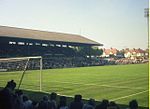Hove Methodist Church
19th-century Methodist church buildings19th-century churches in the United KingdomChurches completed in 1896Churches in Brighton and HoveGrade II listed buildings in Brighton and Hove ... and 2 more
Grade II listed churches in East SussexMethodist churches in East Sussex

Hove Methodist Church is one of five extant Methodist churches in the city of Brighton and Hove, England. Founded on a site on Portland Road, one of Hove's main roads, in the late 19th century by a long-established Wesleyan community, it was extended in the 1960s and is now a focus for various social activities as well as worship. The red-brick building has been listed at Grade II by English Heritage in view of its architectural importance.
Excerpt from the Wikipedia article Hove Methodist Church (License: CC BY-SA 3.0, Authors, Images).Hove Methodist Church
Portland Road,
Geographical coordinates (GPS) Address External links Nearby Places Show on map
Geographical coordinates (GPS)
| Latitude | Longitude |
|---|---|
| N 50.8328 ° | E -0.1792 ° |
Address
Hove Methodist Church
Portland Road
BN3 5DR , Aldrington
England, United Kingdom
Open on Google Maps











